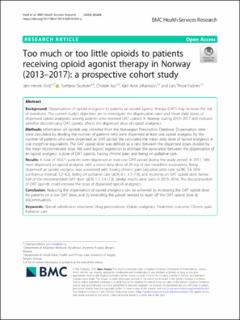| dc.contributor.author | Vold, Jørn Henrik | |
| dc.contributor.author | Skurtveit, Svetlana | |
| dc.contributor.author | Aas, Christer | |
| dc.contributor.author | Johansson, Kjell Arne | |
| dc.contributor.author | Fadnes, Lars Thore | |
| dc.date.accessioned | 2021-04-15T12:01:06Z | |
| dc.date.available | 2021-04-15T12:01:06Z | |
| dc.date.created | 2020-08-06T16:12:34Z | |
| dc.date.issued | 2020 | |
| dc.Published | BMC Health Services Research. 2020, 20 (1), . | |
| dc.identifier.issn | 1472-6963 | |
| dc.identifier.uri | https://hdl.handle.net/11250/2737925 | |
| dc.description.abstract | Background
Dispensations of opioid analgesics to patients on opioid agonist therapy (OAT) may increase the risk of overdoses. The current study’s objectives are to investigate the dispensation rates and mean daily doses of dispensed opioid analgesics among patients who received OAT opioids in Norway during 2013–2017 and evaluate whether discontinuing OAT opioids affects the dispensed dose of opioid analgesics.
Methods
Information on opioids was collected from the Norwegian Prescription Database. Dispensation rates were calculated by dividing the number of patients who were dispensed at least one opioid analgesic by the number of patients who were dispensed an OAT opioid. We calculated the mean daily dose of opioid analgesics in oral morphine equivalents. The OAT opioid dose was defined as a ratio between the dispensed doses divided by the mean recommended dose. We used logistic regression to estimate the association between the dispensation of an opioid analgesic, a dose of OAT opioids, having chronic pain, and being on palliative care.
Results
A total of 10,371 patients were dispensed at least one OAT opioid during the study period. In 2017, 18% were dispensed an opioid analgesic with a mean daily dose of 29 mg of oral morphine equivalents. Being dispensed an opioid analgesic was associated with having chronic pain (adjusted odds ratio (aOR): 3.6, 95% confidence interval: 3.2–4.2), being on palliative care (aOR: 6.1, 4.7–7.9), and receiving an OAT opioid dose below half of the recommended OAT dose (aOR: 1.7, 1.4–2.0). Similar results were seen in 2013–2016. The discontinuation of OAT opioids could increase the dose of dispensed opioid analgesics.
Conclusion
Reducing the dispensation of opioid analgesics can be achieved by increasing the OAT opioid dose for patients on a low OAT dose, and by extending the period needed to taper off the OAT opioid dose at discontinuation. | en_US |
| dc.language.iso | eng | en_US |
| dc.publisher | BMC | en_US |
| dc.rights | Navngivelse 4.0 Internasjonal | * |
| dc.rights.uri | http://creativecommons.org/licenses/by/4.0/deed.no | * |
| dc.title | Too much or too little opioids to patients receiving opioid agonist therapy in Norway (2013–2017): a prospective cohort study | en_US |
| dc.type | Journal article | en_US |
| dc.type | Peer reviewed | en_US |
| dc.description.version | publishedVersion | en_US |
| dc.rights.holder | Copyright The Author(s). 2020 | en_US |
| dc.source.articlenumber | 668 | en_US |
| cristin.ispublished | true | |
| cristin.fulltext | original | |
| cristin.qualitycode | 2 | |
| dc.identifier.doi | 10.1186/s12913-020-05504-y | |
| dc.identifier.cristin | 1822102 | |
| dc.source.journal | BMC Health Services Research | en_US |
| dc.source.40 | 20 | |
| dc.source.14 | 1 | |
| dc.identifier.citation | BMC Health Services Research. 2020, 20, 668. | en_US |
| dc.source.volume | 20 | en_US |

